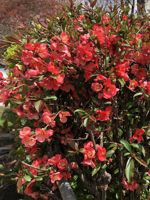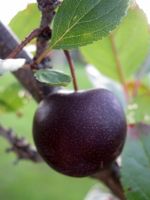Mon-Fri 9am - 5pm Mountain time
Japanese Quince vs Manor Cherry Plum
Chaenomeles japonica
Prunus besseyi x salicina Manor
NOT AVAILABLE THIS SEASON - MIGHT RETURN
Japanese Quince has bright, orange to red showy flowers that bloom in early spring. The flowers appear before the leaves and may continue to bloom after leaves emerge. Flowers grow on old wood, so pruning after flowering will help to promote new growth next spring. They produce yellow-green fruit that taste bitter when eaten raw, typically they are better suited for making preserves.
It can be used as a stand alone ornamental shrub, as a low hedge, or can be trained to grow against a wall. In late winter, branches of Japanese Quince can be cut and brought indoors where they will bloom on their own. They are deer and rabbit tolerant. The branches are spiny making them well suited for keeping unwanted wildlife away.
Manor Cherry Plum has a nice sweet flavour and a hint of astringency, making it a top Cherry Plum variety. They ripen in mid to late August and are well suited to fresh eating, baking, and preserves.
The fruit is closer to a plum than a cherry but is smaller than most plums.The Manor Cherry Plum has thin dark purple skin, nearly black when ripe and the flesh is purplish-red. The flesh is almost freestone and is tender and juicy. Similar to other stone fruits, it does not store for very long but can keep for up to a week in the fridge.
The Manor Cherry Plum is a hybrid between a Western Sand Cherry and a Japanese (Chinese) Plum. For fruit production, it needs to be planted with another variety for cross-pollination. Canada Plum and American Plum are considered universal pollinizers.

